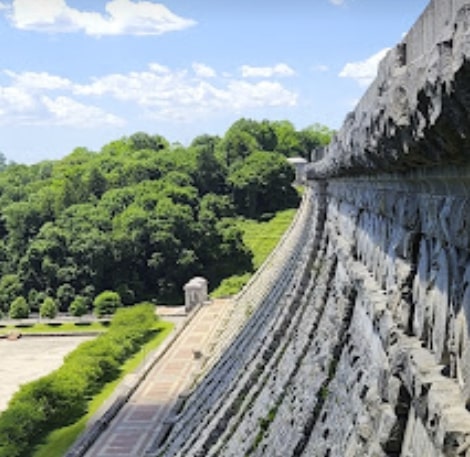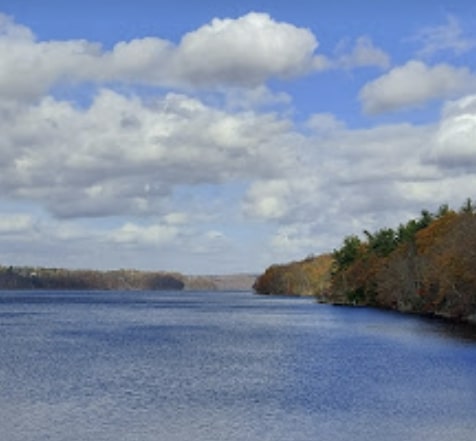
Kensico Dam Plaza, one of the most recognizable sights in the county, is special in that it can gather people from all over Westchester together for enjoyable activities outside.
This historic dam was finished in 1917 and now houses a 9/11 memorial called “The Rising.” This memorial is an open structure that can be accessed from any direction. It is surrounded by spaces suitable for activities such as picnicking, in-line skating, nature hikes, and more.
The historic dam serves as a backdrop at the Kensico Dam Plaza, which features several intriguing subjects to sketch, such as fountains, the 9-11 memorial, gorgeous trees, and many people enjoying the park setting.
Those who are prepared for an exciting challenge can hike up the winding steps or take the brick walk-up path to the summit, where they will be rewarded with a breathtaking panorama of the Kensico Dam and Reservoir.
History
At the beginning of the 20th century, New York City had rapid population growth, which increased the need for water. The Croton Reservoir, located in Westchester County, was the source of the first water brought in from the surrounding area in 1842.
The reservoir’s capacity was later increased over several decades. When it became clear that this method would not be sufficient, the city authorities decided to construct a dam in Kensico in 1885 to collect water from the Bronx River and the Byram River.
They decided to build an even larger dam in Kensico to create a reservoir to supply the city with water already stored in other reservoirs. This decision was made because the city’s needs grew further over time.
The project was enormous and carried out in several stages, beginning with the tearing down of the old dam and the construction of a new train line so that stone and debris could be transported to and from the construction site.
Under the original dam that created Lake Kensico, the historically significant Kensico Dam was constructed with stone taken from the neighboring Cranberry Lake Park. 1917 was the year that saw the completion of the dam.
It forms the Kensico reservoir and measures 307 feet in height and 1,843 feet in length. The significance of The Rising, the county’s September 11th Memorial, is felt throughout the surrounding terrain due to its location at the confluence of several trails and overlooks that pay tribute to this 9/11 monument.
Functionality
The water flows unimpeded from the basin on the western side of Kensico Reservoir to the bay on the eastern side of Rye Lake. The dam was built in 1915 and reached a maximum capacity of 30.62 billion gallons throughout its lifetime.
The Kensico Reservoir’s principal purpose is to act as a collection point for water coming from the other five reservoirs that are part of the Catskill and Delaware system. This water is then made available to New York City to meet its population’s ever-changing water needs.
This water from Delaware and Catskill is distributed throughout New York City through a network of pipes.
Even though it contributes around 2% of the total water supply, Kensico Reservoir receives water from a watershed before reaching the reservoir. Before the water enters the distribution network, it is stored at the Kensico Reservoir, the last water source in the Catskill/Delaware network. As a result, stringent enforcement of federal water quality rules for coliforms and turbidity may be seen there.
The drainage basin for the Kensico watershed has a total area of thirteen square miles. It includes portions of the following municipalities: Harrison, Mount Pleasant, North Castle, and even a little portion of Fairfield County, Connecticut.
Attractions

The Kensico Dam has a plaza. The plaza is a park. The Westchester County Department of Parks hosts free outdoor movie screenings in the summer and early autumn and celebrations with fireworks on the 4th of July with music and food trucks.
There’s a playground, grass, gravel roads for walking and biking, and a hiking route from the plaza to the dam’s crest so visitors can have fun. Plaques describe the plaza’s history.
At Kensico Dam Plaza, you may learn about various cultures. Listen to music, enjoy excellent food, and buy at booths. Polish, Asian-American, Indian, Jewish, Irish, and Muslim cultures are presented weekly.
Movie nights, Fourth of July fireworks, Westchester’s Winter Wonderland, and a year-round, highly-visited foot and bike path have all contributed to the Kensico Dam’s status as a popular destination for Westchester families.
Children have always been drawn to the Playground because of all the different things they can do there. Furthermore, the Playground had a complete makeover with all new playsets, picnic tables, and more. The Kensico Dam Plaza has one entrance and offers free parking.
Aquatic Life
A vigorous population of gamefish, including brown trout, lake trout, smallmouth bass, largemouth bass, perch, and grass pickerel, is maintained in Kensico Reservoir through stocking efforts in addition to natural reproduction.
The magnitude and depth of the reservoir make it ideal for the growth of lake trout. In many locations, fishermen cast their lines from the shore, and the Department of Environmental Conservation only allows aluminum rowboats licensed and inspected to be used for boating.
On the reservoir, power boats and other types of recreational watercraft, including canoes, kayaks, and rafts, are not allowed at any time.

Conclusion
Before visiting the Kensico dam, it is important to do a little research and go through the fundamentals so you will be aware of the environment! The dos and donts, the history. Everything works in your favor.
